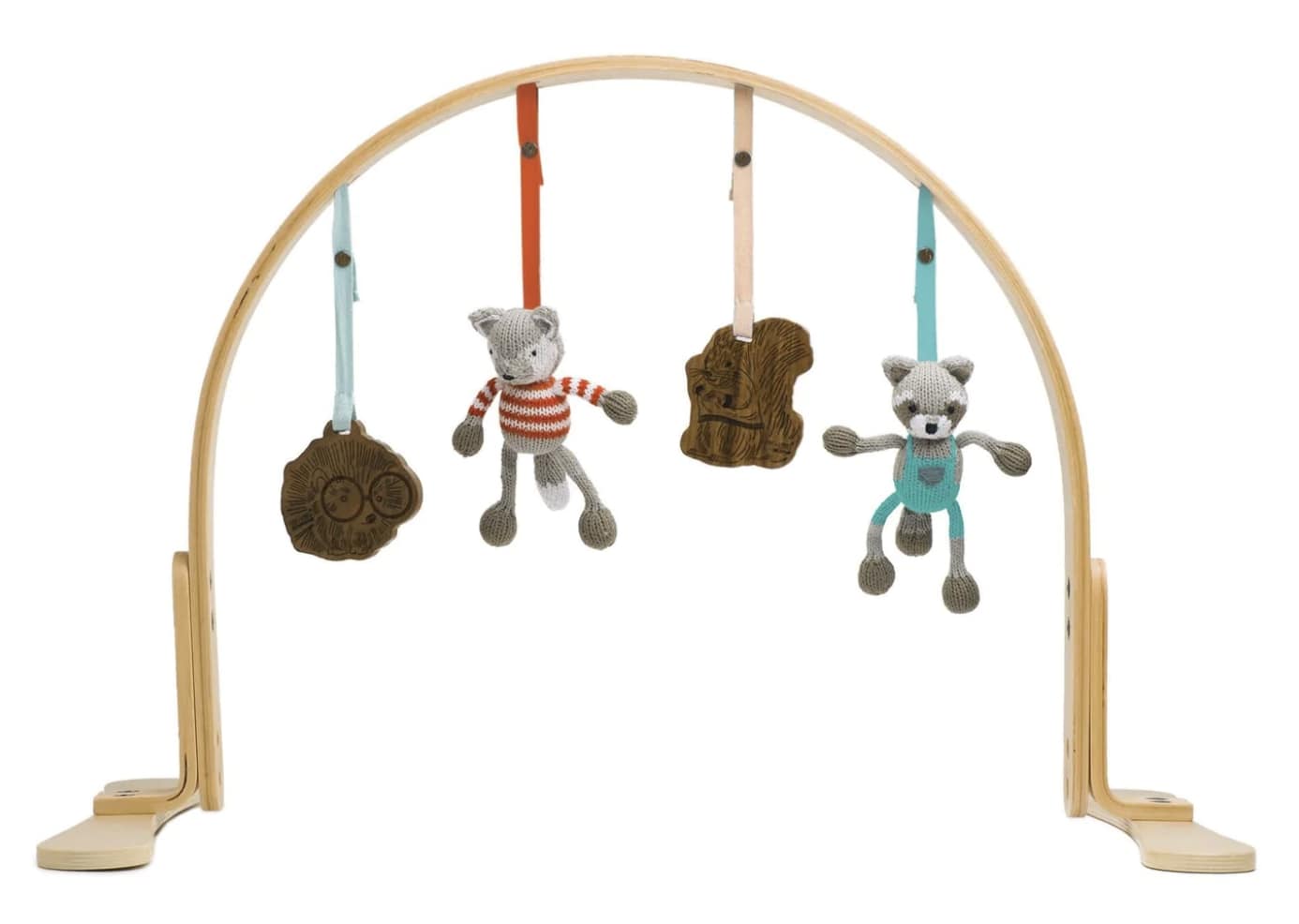Knowing when do babies roll over will ensure you can help your baby on their developmental journey and set them up to learn how to sit, stand, and eventually, walk. Find out when babies roll over and what you must do if they show no signs of rolling over just yet.

Table of Contents
Key Takeaways:
- Rolling over is a developmental milestone that typically occurs between 4 and 6 months, but may happen earlier or later.
- Encouraging tummy time and providing a safe and stimulating environment can help promote your baby’s physical development and increase their chances of rolling over.
- Rolling over from tummy to back usually happens first and before rolling over from back to tummy.
When Do Babies Roll Over?
Babies will start to roll over around 4 months old. When your baby reachs 6-7 months of age, they will be able to roll over from front to back and back to front.
6 Subtle Signs Baby Is Going To Roll Over
Here are the 6 signs that I always look out for that indicate when babies will start to roll. Keep your eyes peeled so you can help baby learn to roll over:
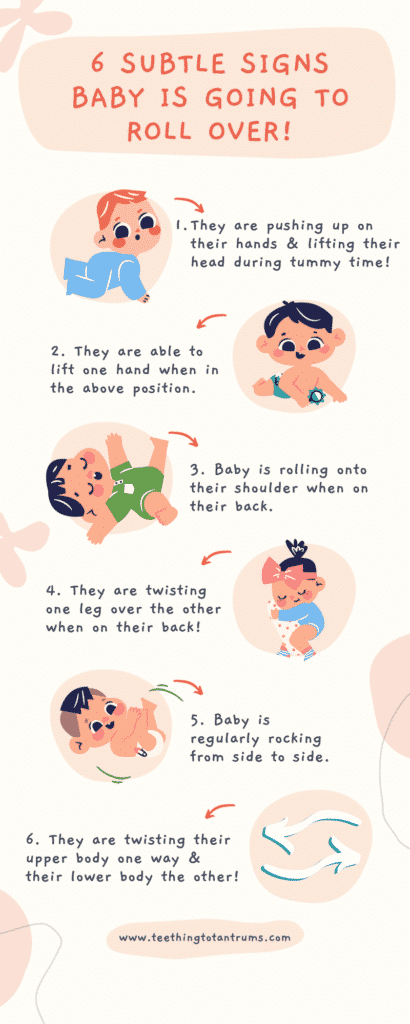
- Baby is pushing up onto their hands and lifting their upper body during tummy time, indicating their neck muscles and head control are getting ready to roll.
- Baby is able to lift one hand in the air while in the tummy time position to reach out for a toy. This indicates that baby’s arm muscles, upper body muscles and motor development are on track too!
- Baby will begin rolling onto their shoulder when lying on their back.
- Baby will start rolling one leg over the other when lying on their back. (This is a sure sign baby is trying to roll from front to back)
- Baby will begin twisting their upper body and their lower body in opposite directions.
- Baby is regularly rocking from side to side.
But what happens if your baby is not showing signs of rolling over yet?
Is Your Baby Showing No Signs Of Rolling Over?
If your baby is showing no signs of rolling over, it can indicate that they are experiencing a delay in their physical development.
And if your baby has not rolled over by 6 months, and is showing no signs of sitting or bum shuffling…
I recommend that you visit your pediatrician or healthcare provider to rule out any underlying medical conditions or developmental delays.
But remember, rolling over is a developmental milestone that most babies achieve between the ages of 4 and 7 months.
It’s important to remember that every baby develops at their own pace, and there is no need to worry if your baby is not rolling over as soon as their peers.
Some babies skip rolling over altogether and progress straight to crawling or sitting up.
I have encountered many babies who have done this!
The most important thing you must do is to provide a safe and stimulating environment, encourage tummy time, and give your baby plenty of opportunities to move around to refine their motor skills and promote their physical development.
Exercises To Help Your Baby Learn To Roll Over
Your baby’s ability to roll over is one of the first major developmental milestones that they will achieve.
But it is important that you offer your little one plenty of opportunities to learn and practice this new skill.
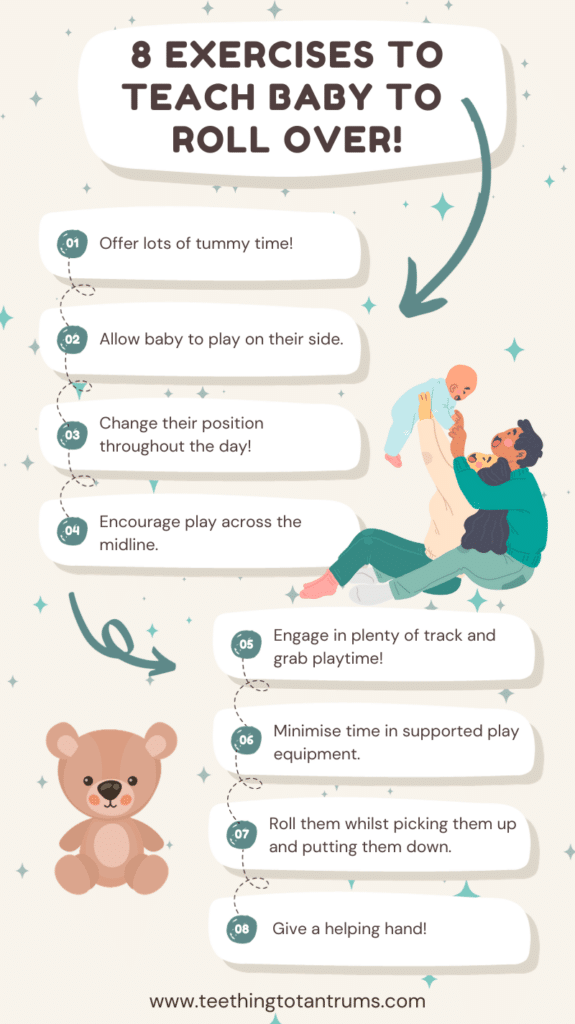
1. Tummy Time
We all know how good tummy time is for newborns and it really is great for helping your baby to strengthen their upper body in preparation for rolling over too.
Place toys just out of reach to encourage your little one to reach out and grab them.
Tummy time mirrors are always a good choice and when you want to entice your baby to roll over place the mirror to one side a little out of reach to tempt them to roll and stretch.
Start by doing tummy time for a few minutes several times a day. As your baby reaches 3 months old, increase the duration of tummy time sessions so your baby is doing 20-30 minutes per day.
Continue to increase the length of the tummy time sessions as baby grows and incorporate plenty of engaging activities to keep baby interested.
We all know the importance of tummy time and there is no better way to keep your baby engaged during this essential activity than with a tummy time mirror. This one from Sassy is sturdy but soft and has a large good quality mirror that is guaranteed to grab baby's attention. It also comes in a black and white colourway.
NOTE: Wondering what tummy time is? Read this post: What Is Tummy Time? Oh, and if your baby struggles with tummy time, read this post: What To Do When Baby Hates Tummy Time.
2. Allow Baby To Play On Their Side
Placing your baby on their side with a rolled-up towel or blanket propped at their back is a great way to get your baby primed for rolling over.
Place toys in their line of sight but just out of reach to keep baby engaged and as they stretch to grab the toy, they will naturally cross their top leg over and one day they will just roll over!
3. Change Positions A Lot
During the day, try to put your baby in different positions to play as time spent on their sides, back and tummy will strengthen all the different muscles needed for rolling over.
You can also carry your baby in different positions to improve their balance and ability to hold themselves in different positions, which will help encourage them to roll over.
Try holding your baby so they’re sitting in your arms facing forwards or flat on their tummy along your arm, also facing outwards.
4. Encourage Play Across The Midline
Between the ages of 4 and 5 months, teaching your baby to reach across the midline is another good way to get them ready to roll over.
Activity gyms are great for entertaining your little one and they ideal for providing your baby with tempting opportunities to reach and roll when they are ready.
Place your baby under a play gym with a toy attached slightly to one side, so they need to reach up and across to touch it.
There are so many play gyms out there and lots of them are great but I was especially impressed by this one from Finn and Emma. This company do a great range of toys and baby gear and I often feel that for small babies less is more so really like the simple classy design of this play gym.
5. Engage In Track And Grab Playtime
Lay your baby on their back and hold up an interesting toy for them to look at.
Next, move the toy from side to side for your baby’s eyes to follow, and encourage your baby to reach out… preferably across the midline.
Use developmental toys that light up, make a noise, or have bold patterns and fun textures to keep baby’s interest.
Looking for a fun and safe sensory toy for your baby? Look no further than the Manhattan Toy Winkel Sensory Teether. With its unique design and multiple textures, this teether is perfect for soothing sore gums and promoting sensory development. Made from safe, non-toxic materials, the Winkel Sensory Teether is easy to clean and perfect for babies of all ages.(Whether they're teething or not!)
6. Minimise Time In Supported Play Equipment
Keep your baby’s time in baby bouncers and chairs to a minimum. This is because your little one cannot practice any pre-rolling skills when they are in these devices.
Baby bouncers and chairs can also cause developmental issues if used too much.
7. Roll Your Baby While Picking Them Up And Putting Them Down
As you pick up and put your baby down, do so in a rolling motion rather than straight up and down.
This can be done from a young age and helps to strengthen the muscles necessary for rolling.
It also helps your baby to get used to the movement and visual changes that happen when rolling.
8. Give A Helping Hand
If your baby is getting halfway into a roll but gets stuck, give them a hand! Helping your little one get past a sticking point over and over again will teach them what it actually feels like to roll.
Here’s a really quick video to show you how to give your baby a helping hand if they get stuck when rolling:
TOP TIP: Some babies get a shock the first time they roll over and may cry. This is quite normal and you simply need to comfort your little one and let them know there is nothing to be scared of.
Looking to get your little one to sleep quickly and effortlessly? Check out my Bedtime and Nap Cheat Sheet and master the art of making daytime naps and bedtimes as seamless as possible.
A bedtime & nap cheat sheet so good your little one will ask you to put them to bed...
Laura Williams "This is a life saver! I'm so glad I downloaded your bedtime & nap cheat sheet. My little one actually asked me to put him to bed last night! Unbelievable! Thank you so much!"
Click Here For The FREE Cheat Sheet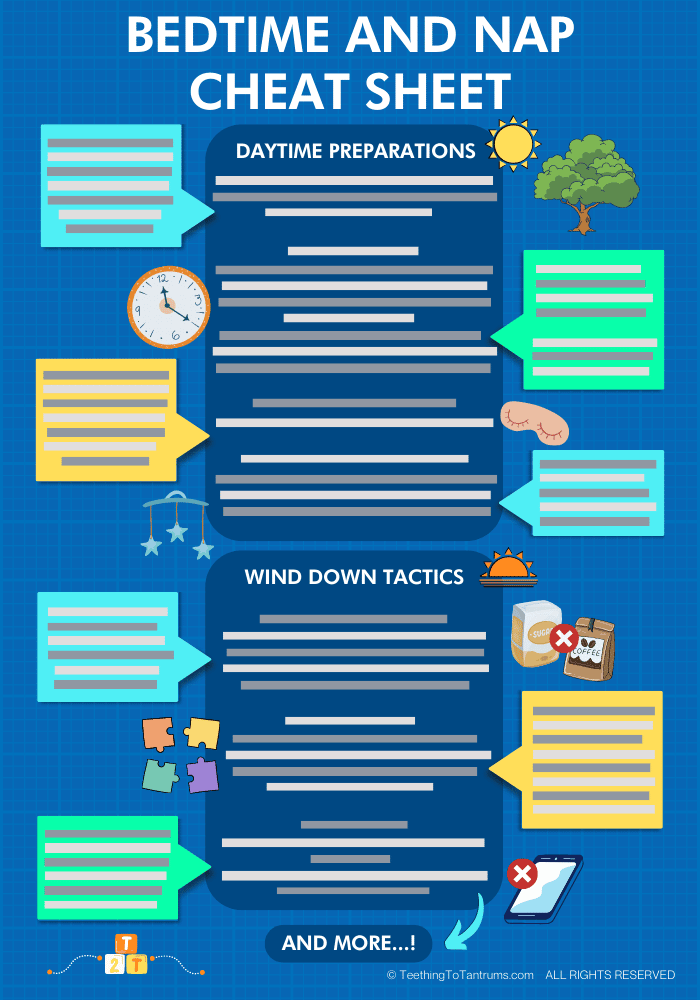
How To Teach A Baby To Roll Over
Once your baby is showing signs of rolling over and you are offering plenty of practice time, you’ll want to give baby a helping hand to refine their rolling technique.
Here is the simple method I use to teach a baby how to roll over:
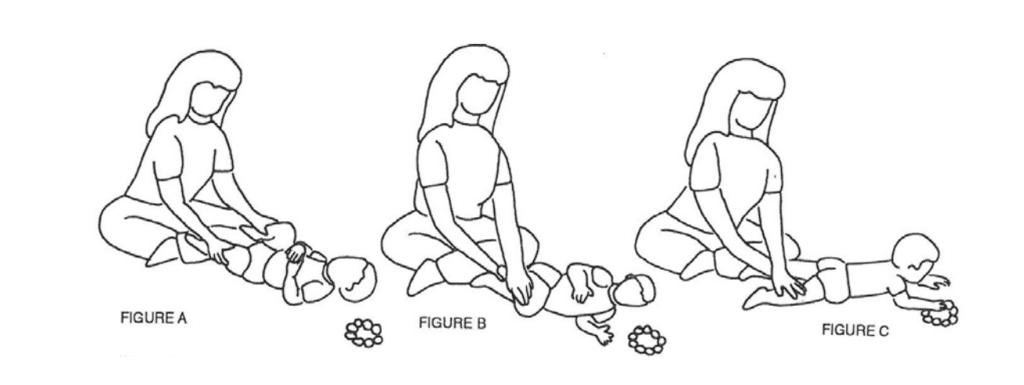
Image Credit: NHS Children and Family Health Surrey
- Start by placing your baby on their back on a soft, flat surface. This will give them plenty of room to move around and explore safely.
- Encourage your baby to lift their head and shoulders by placing age-appropriate developmental toys or other objects just out of reach. The looking and reaching actions will help them develop the muscles they need to roll over.
- Once the baby is able to lift their head and shoulders, strategically place a toy to the side of your baby in preparation for a roll.
- Starting on their back, gently bend and bring baby’s outside leg up and across their body to begin a ‘roll’. (The outside leg is the leg on the other side of baby’s body to the toy you placed down)
- As they roll over, gradually straighten their leg and let your little one naturally bring their hands forward and reach for the toy to help them finish the roll.
- Allow them to play on their tummy with the toy on then practice rolling them back and trying again!
- As the baby becomes more comfortable with the motion, you can gradually reduce the amount of support you provide, allowing them to do more of the rolling on their own.
NOTE: If you are a visual learner, check out Corinne Hagins’ Starfish Therapies‘ lovely YouTube video showing this exact technique in practice.
Once Baby Has Learned To Roll Over, What Are Their Next Milestones?
Once your baby has learned to roll over there are lots of exciting milestones to look forward to that will follow as their physical development progresses. The next major physical developmental milestones will be:
- Sitting,
- Learning to crawl,
- Pulling to stand,
- Cruising around furniture,
- And walking.
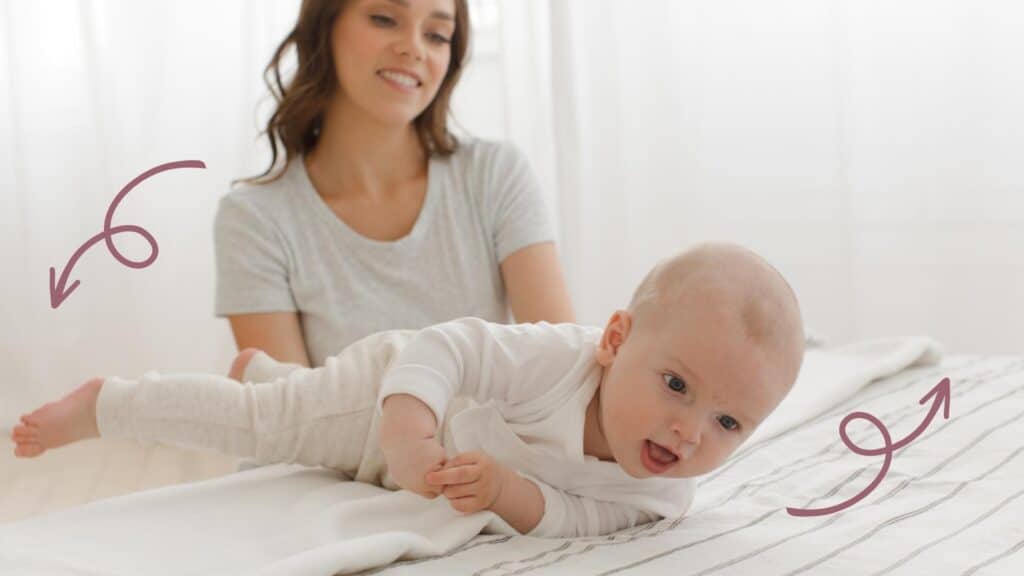
When Do Babies Roll Over: Frequently Asked Questions
Looking for more information about when babies roll over? Here are the answers to the most commonly asked questions.
Q: Which way do babies roll over first?
A: Babies will roll from tummy to back first. Between the ages of 3 and 5 months old. Babies will roll from back to tummy later, as this requires more advanced and developed coordination.
Q: When do premature babies roll over?
A: Depending on how premature your baby was, they may develop more slowly. This can mean that they achieve their developmental milestones later than would be expected of a baby born at full term. As a result, it would not be unusual for a premature baby to start rolling over later than expected. Usually around 6-7 months of age.
REMEMBER: If your baby was born prematurely, they should catch up developmentally by the age of 2.
Q: Can babies roll over at 2 months?
A: Yes, it is possible for babies to start rolling over at 2 months old, although it’s not very common. If your baby is rolling over at 2 months, it’s important to make sure that they are always supervised during tummy time and when they are lying on their back, to reduce the risk of a potential suffocation hazard. Especially as your baby may accidentally roll over and get stuck in a position that makes it difficult for them to breathe.
Q: Is rolling over at 3 months early?
A: Yes, rolling over at 3 months old is considered early in terms of the typical developmental timeline for this milestone. Encouraging your baby’s physical development through tummy time and other age-appropriate activities can help promote their motor skills.
Q: How long should you do tummy time?
A: You should start doing tummy time with your baby for a 2-5 minutes, several times a day. As your baby reaches 3 months old, increase the duration of tummy time sessions so they’re doing 30-45 minutes per day.
Continue to increase the length of your tummy time sessions as baby grows and incorporate plenty of engaging activities to keep your little one interested.
Q: What to do if baby is showing no signs of rolling over?
A: If your baby has not started to roll by 6 months of age and is not showing signs of sitting or bottom shuffling, then you should consult a pediatrician or medical professional. It is always important to remember that the age at which babies roll over will vary quite significantly from child to child. A few babies may only roll occasionally, being quite happy to wait until they can sit. Others will be keen to roll immediately!
Q: What can you do if baby rolls over in their sleep?
A: If your baby is rolling over in their sleep, you can always roll them back. However this solution is not practical when you’re trying to get a good night’s sleep. Therefore, you must not swaddle a baby that can roll over as they need their arms free to push themselves back. A sleep sack or sleeping bag is ideal for this developmental stage to keep baby safe.
Ensure you have safe sleep practices too. Crib safety is vitally important for a developing baby. Ensure the crib height, crib setting, and crib mattress are all safe, well-positioned, and free from damage. Use a tight-fitting crib sheet and never use crib bumpers.
REMEMBER: When babies are able to roll over, they will also be able to move their heads from side to side and push themselves up to lift their heads to breathe freely. But if you are at all concerned, trust your instincts and contact your pediatrician.
Q: Do some babies skip rolling over?
A: Yes. A few babies will avoid the rolling over stage and go straight to crawling or bum shuffling. As long as your little one is progressing physically and building strength in their upper body there is nothing to be concerned about.
Do I need to prepare for my baby rolling over?
A: Yes, you definitely need to prepare yourselves and your house before your child can roll over as you will be surprised how far and how quickly your baby can roll into trouble.
To create a safe environment cover electric sockets, and remove all dangling items such as cables, curtain cords, and tablecloths. Most importantly, never leave your infant on an elevated surface unattended.
Need More Parenting Help?
- Download our FREE Bedtime & Nap Sleep Cheat Sheet. It’s a free, easy-to-use and proven formula designed for parents of 0-5 year olds to master the art of consistently undisturbed and restful sleep without the yelling, nagging or exhausting long-winded evenings.
- Check out our Parenting Toolbox. You’ll get access to expertly-chosen products that you can guarantee are the best for your little one and your wallet.
- Are you looking for personalized guidance to navigate the challenges of parenting? I offer 1-on-1 consultations to bring you tailored strategies and actionable advice to help support your child's growth and well-being with confidence.

A bedtime & nap cheat sheet so good your little one will ask you to put them to bed...
Laura Williams "This is a life saver! I'm so glad I downloaded your bedtime & nap cheat sheet. My little one actually asked me to put him to bed last night! Unbelievable! Thank you so much!"
Click Here For The FREE Cheat Sheet

